Project Plan: Big Data Tools & Implementation in Government
VerifiedAdded on 2023/04/06
|10
|1649
|159
Project
AI Summary
This document presents a project plan focused on the utilization of Big Data by the government to enhance data analysis, pattern recognition, and trend identification. It addresses the problem domain of managing vast datasets, aiming to improve national security, data confidentiality, and global competitiveness. The plan outlines research questions, a conceptual framework, and a phased methodology for implementation, including planning, execution, control, and closure. It also includes an analysis of information sources, research methods, data collection strategies, ethical considerations, compliance requirements, deliverables such as an annotated bibliography and journal paper, a work breakdown structure (WBS), risk analysis, and a Gantt chart illustrating the project timeline. The project aims to provide a roadmap for governments to effectively leverage Big Data tools for improved services, economic development, and national security.
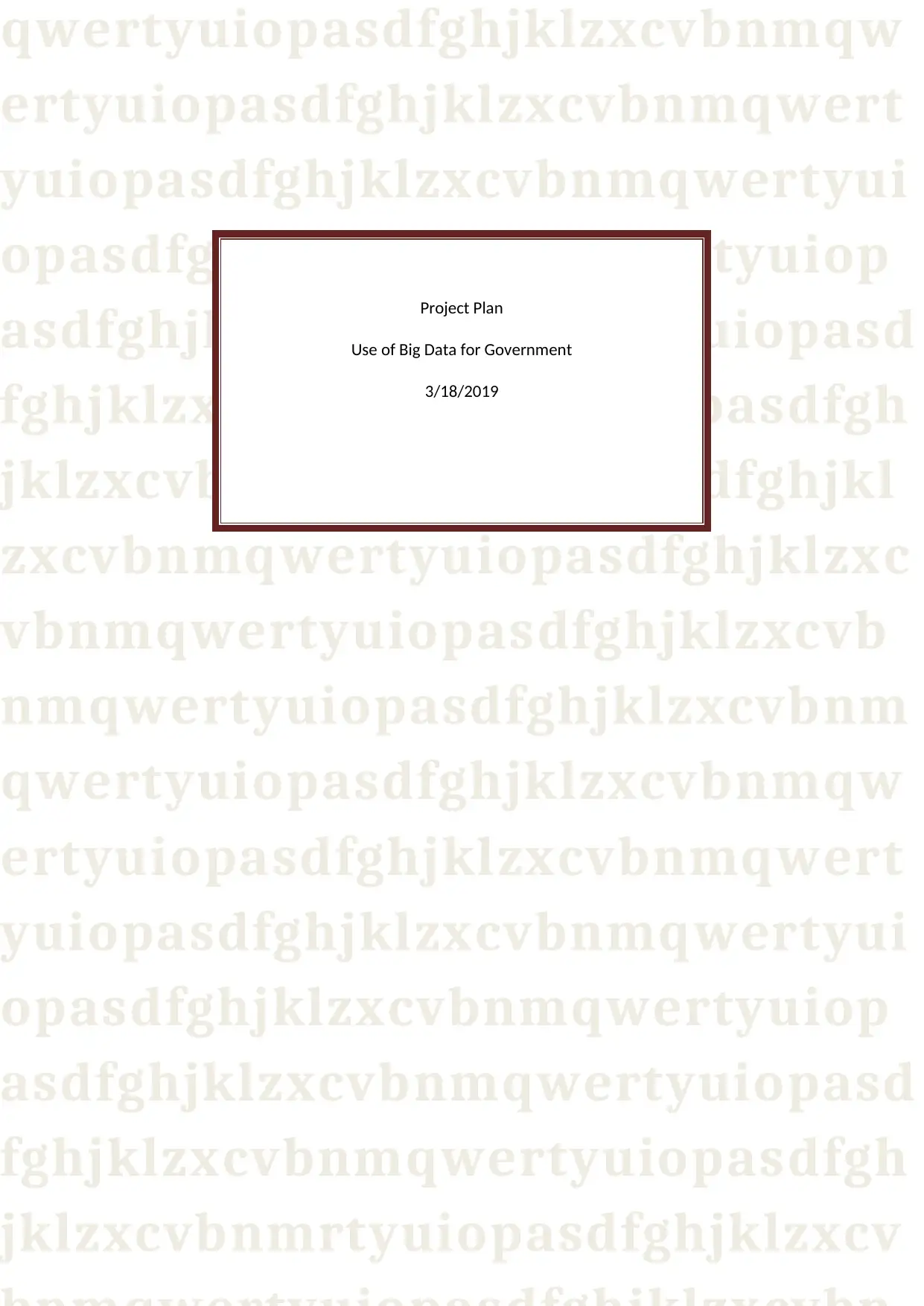
qwertyuiopasdfghjklzxcvbnmqw
ertyuiopasdfghjklzxcvbnmqwert
yuiopasdfghjklzxcvbnmqwertyui
opasdfghjklzxcvbnmqwertyuiop
asdfghjklzxcvbnmqwertyuiopasd
fghjklzxcvbnmqwertyuiopasdfgh
jklzxcvbnmqwertyuiopasdfghjkl
zxcvbnmqwertyuiopasdfghjklzxc
vbnmqwertyuiopasdfghjklzxcvb
nmqwertyuiopasdfghjklzxcvbnm
qwertyuiopasdfghjklzxcvbnmqw
ertyuiopasdfghjklzxcvbnmqwert
yuiopasdfghjklzxcvbnmqwertyui
opasdfghjklzxcvbnmqwertyuiop
asdfghjklzxcvbnmqwertyuiopasd
fghjklzxcvbnmqwertyuiopasdfgh
jklzxcvbnmrtyuiopasdfghjklzxcv
Project Plan
Use of Big Data for Government
3/18/2019
ertyuiopasdfghjklzxcvbnmqwert
yuiopasdfghjklzxcvbnmqwertyui
opasdfghjklzxcvbnmqwertyuiop
asdfghjklzxcvbnmqwertyuiopasd
fghjklzxcvbnmqwertyuiopasdfgh
jklzxcvbnmqwertyuiopasdfghjkl
zxcvbnmqwertyuiopasdfghjklzxc
vbnmqwertyuiopasdfghjklzxcvb
nmqwertyuiopasdfghjklzxcvbnm
qwertyuiopasdfghjklzxcvbnmqw
ertyuiopasdfghjklzxcvbnmqwert
yuiopasdfghjklzxcvbnmqwertyui
opasdfghjklzxcvbnmqwertyuiop
asdfghjklzxcvbnmqwertyuiopasd
fghjklzxcvbnmqwertyuiopasdfgh
jklzxcvbnmrtyuiopasdfghjklzxcv
Project Plan
Use of Big Data for Government
3/18/2019
Paraphrase This Document
Need a fresh take? Get an instant paraphrase of this document with our AI Paraphraser
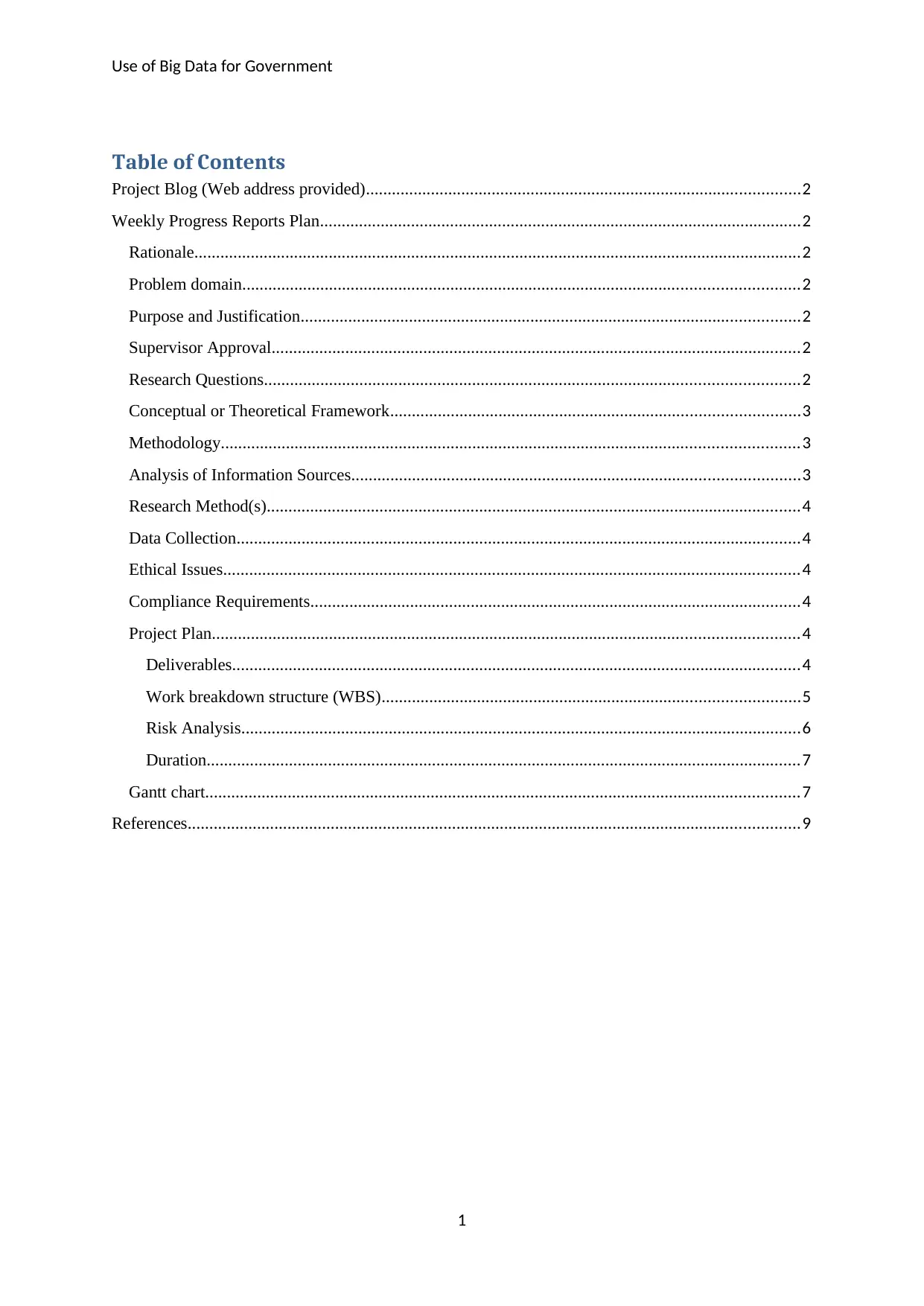
Use of Big Data for Government
Table of Contents
Project Blog (Web address provided)....................................................................................................2
Weekly Progress Reports Plan...............................................................................................................2
Rationale............................................................................................................................................2
Problem domain................................................................................................................................2
Purpose and Justification...................................................................................................................2
Supervisor Approval..........................................................................................................................2
Research Questions...........................................................................................................................2
Conceptual or Theoretical Framework..............................................................................................3
Methodology.....................................................................................................................................3
Analysis of Information Sources.......................................................................................................3
Research Method(s)...........................................................................................................................4
Data Collection..................................................................................................................................4
Ethical Issues.....................................................................................................................................4
Compliance Requirements.................................................................................................................4
Project Plan.......................................................................................................................................4
Deliverables...................................................................................................................................4
Work breakdown structure (WBS)................................................................................................5
Risk Analysis.................................................................................................................................6
Duration.........................................................................................................................................7
Gantt chart.........................................................................................................................................7
References.............................................................................................................................................9
1
Table of Contents
Project Blog (Web address provided)....................................................................................................2
Weekly Progress Reports Plan...............................................................................................................2
Rationale............................................................................................................................................2
Problem domain................................................................................................................................2
Purpose and Justification...................................................................................................................2
Supervisor Approval..........................................................................................................................2
Research Questions...........................................................................................................................2
Conceptual or Theoretical Framework..............................................................................................3
Methodology.....................................................................................................................................3
Analysis of Information Sources.......................................................................................................3
Research Method(s)...........................................................................................................................4
Data Collection..................................................................................................................................4
Ethical Issues.....................................................................................................................................4
Compliance Requirements.................................................................................................................4
Project Plan.......................................................................................................................................4
Deliverables...................................................................................................................................4
Work breakdown structure (WBS)................................................................................................5
Risk Analysis.................................................................................................................................6
Duration.........................................................................................................................................7
Gantt chart.........................................................................................................................................7
References.............................................................................................................................................9
1
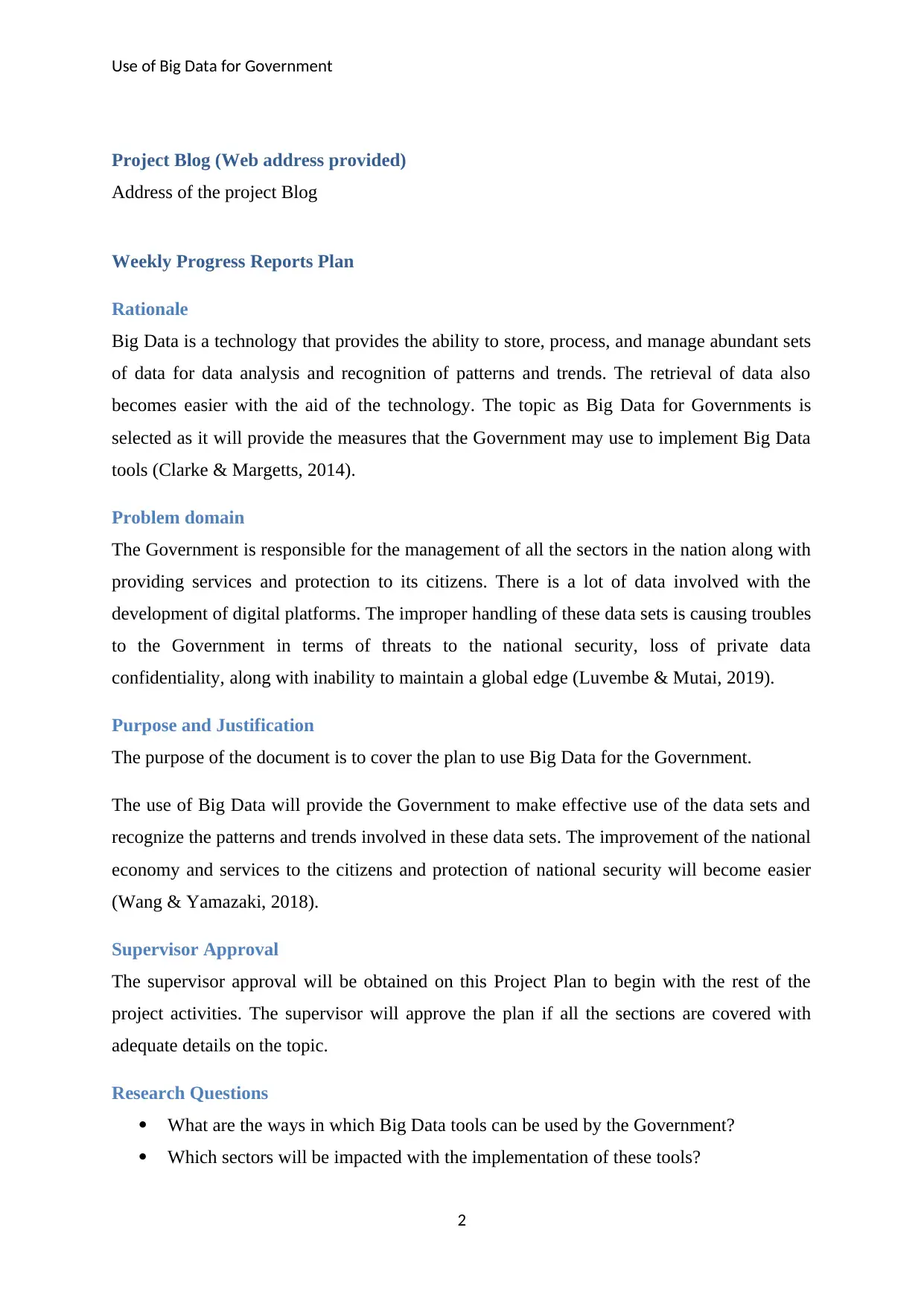
Use of Big Data for Government
Project Blog (Web address provided)
Address of the project Blog
Weekly Progress Reports Plan
Rationale
Big Data is a technology that provides the ability to store, process, and manage abundant sets
of data for data analysis and recognition of patterns and trends. The retrieval of data also
becomes easier with the aid of the technology. The topic as Big Data for Governments is
selected as it will provide the measures that the Government may use to implement Big Data
tools (Clarke & Margetts, 2014).
Problem domain
The Government is responsible for the management of all the sectors in the nation along with
providing services and protection to its citizens. There is a lot of data involved with the
development of digital platforms. The improper handling of these data sets is causing troubles
to the Government in terms of threats to the national security, loss of private data
confidentiality, along with inability to maintain a global edge (Luvembe & Mutai, 2019).
Purpose and Justification
The purpose of the document is to cover the plan to use Big Data for the Government.
The use of Big Data will provide the Government to make effective use of the data sets and
recognize the patterns and trends involved in these data sets. The improvement of the national
economy and services to the citizens and protection of national security will become easier
(Wang & Yamazaki, 2018).
Supervisor Approval
The supervisor approval will be obtained on this Project Plan to begin with the rest of the
project activities. The supervisor will approve the plan if all the sections are covered with
adequate details on the topic.
Research Questions
What are the ways in which Big Data tools can be used by the Government?
Which sectors will be impacted with the implementation of these tools?
2
Project Blog (Web address provided)
Address of the project Blog
Weekly Progress Reports Plan
Rationale
Big Data is a technology that provides the ability to store, process, and manage abundant sets
of data for data analysis and recognition of patterns and trends. The retrieval of data also
becomes easier with the aid of the technology. The topic as Big Data for Governments is
selected as it will provide the measures that the Government may use to implement Big Data
tools (Clarke & Margetts, 2014).
Problem domain
The Government is responsible for the management of all the sectors in the nation along with
providing services and protection to its citizens. There is a lot of data involved with the
development of digital platforms. The improper handling of these data sets is causing troubles
to the Government in terms of threats to the national security, loss of private data
confidentiality, along with inability to maintain a global edge (Luvembe & Mutai, 2019).
Purpose and Justification
The purpose of the document is to cover the plan to use Big Data for the Government.
The use of Big Data will provide the Government to make effective use of the data sets and
recognize the patterns and trends involved in these data sets. The improvement of the national
economy and services to the citizens and protection of national security will become easier
(Wang & Yamazaki, 2018).
Supervisor Approval
The supervisor approval will be obtained on this Project Plan to begin with the rest of the
project activities. The supervisor will approve the plan if all the sections are covered with
adequate details on the topic.
Research Questions
What are the ways in which Big Data tools can be used by the Government?
Which sectors will be impacted with the implementation of these tools?
2
⊘ This is a preview!⊘
Do you want full access?
Subscribe today to unlock all pages.

Trusted by 1+ million students worldwide

Use of Big Data for Government
What is the methodology that shall be adopted for implementation at such a large-
scale?
What are the issues and concerns that may appear?
Conceptual or Theoretical Framework
Conceptual Model (Daki, El Hannani, Aqqal, Haidine & Dahbi, 2017)
The conceptual model for the use of Big Data by the Government is depicted in the image
above. There are different elements that are involved in the process and the integration of
these processes shall be done effectively.
Methodology
The methodology that shall be carried out for the research process is exploratory research
using qualitative analysis. The implementation methodology for Big Data shall be phased
methodology in which there shall be several phases involved. These shall include the
planning phase in which the detailed planning regarding implementation, procurement,
project management, etc. shall be done. The execution phase shall come next in the
methodology followed by control and closure processes (Smyth, 2016).
Analysis of Information Sources
The information sources for the project plan include the peer reviewed journal articles,
academic papers, and web sources that have been referenced using APA referencing style.
3
What is the methodology that shall be adopted for implementation at such a large-
scale?
What are the issues and concerns that may appear?
Conceptual or Theoretical Framework
Conceptual Model (Daki, El Hannani, Aqqal, Haidine & Dahbi, 2017)
The conceptual model for the use of Big Data by the Government is depicted in the image
above. There are different elements that are involved in the process and the integration of
these processes shall be done effectively.
Methodology
The methodology that shall be carried out for the research process is exploratory research
using qualitative analysis. The implementation methodology for Big Data shall be phased
methodology in which there shall be several phases involved. These shall include the
planning phase in which the detailed planning regarding implementation, procurement,
project management, etc. shall be done. The execution phase shall come next in the
methodology followed by control and closure processes (Smyth, 2016).
Analysis of Information Sources
The information sources for the project plan include the peer reviewed journal articles,
academic papers, and web sources that have been referenced using APA referencing style.
3
Paraphrase This Document
Need a fresh take? Get an instant paraphrase of this document with our AI Paraphraser
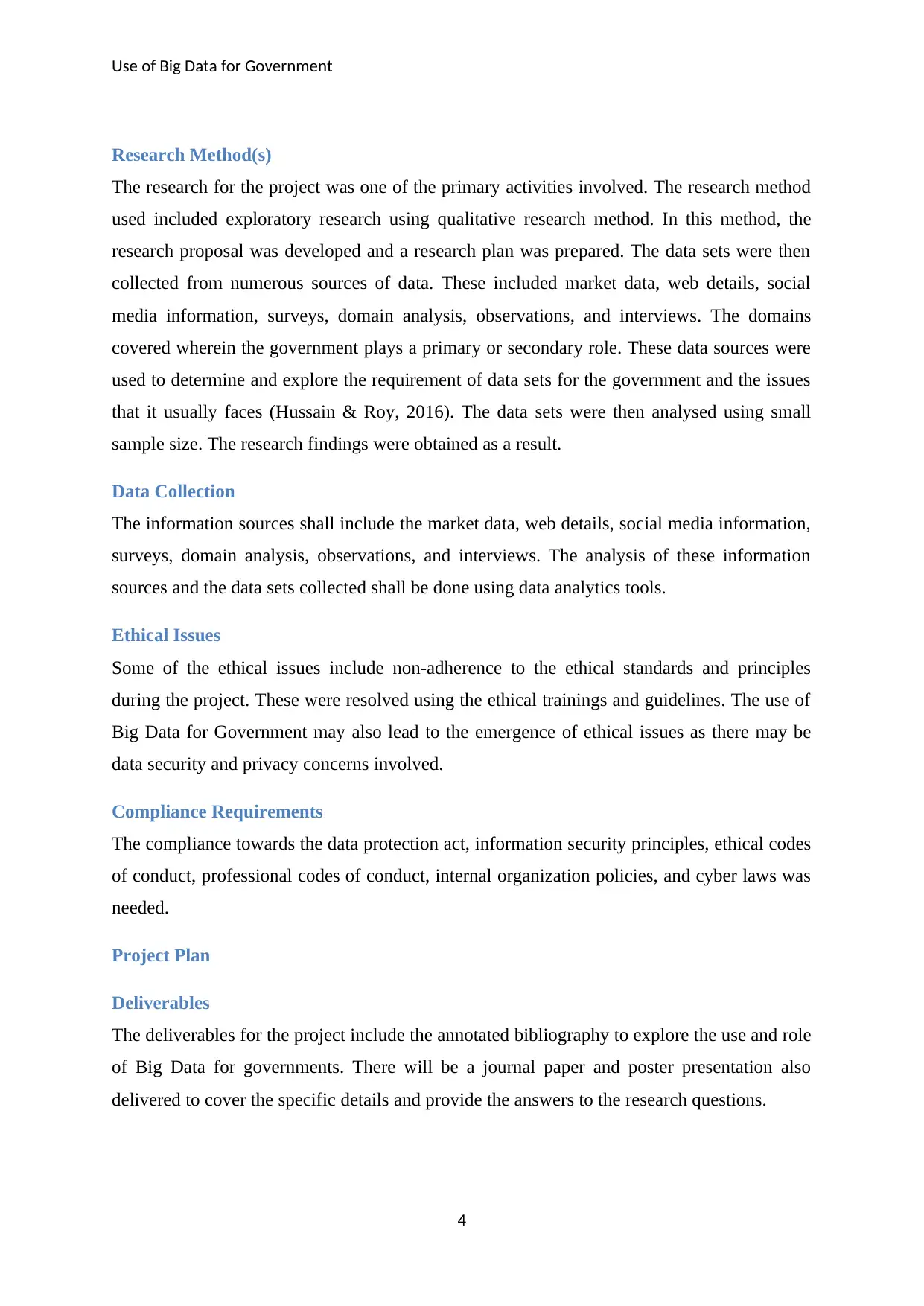
Use of Big Data for Government
Research Method(s)
The research for the project was one of the primary activities involved. The research method
used included exploratory research using qualitative research method. In this method, the
research proposal was developed and a research plan was prepared. The data sets were then
collected from numerous sources of data. These included market data, web details, social
media information, surveys, domain analysis, observations, and interviews. The domains
covered wherein the government plays a primary or secondary role. These data sources were
used to determine and explore the requirement of data sets for the government and the issues
that it usually faces (Hussain & Roy, 2016). The data sets were then analysed using small
sample size. The research findings were obtained as a result.
Data Collection
The information sources shall include the market data, web details, social media information,
surveys, domain analysis, observations, and interviews. The analysis of these information
sources and the data sets collected shall be done using data analytics tools.
Ethical Issues
Some of the ethical issues include non-adherence to the ethical standards and principles
during the project. These were resolved using the ethical trainings and guidelines. The use of
Big Data for Government may also lead to the emergence of ethical issues as there may be
data security and privacy concerns involved.
Compliance Requirements
The compliance towards the data protection act, information security principles, ethical codes
of conduct, professional codes of conduct, internal organization policies, and cyber laws was
needed.
Project Plan
Deliverables
The deliverables for the project include the annotated bibliography to explore the use and role
of Big Data for governments. There will be a journal paper and poster presentation also
delivered to cover the specific details and provide the answers to the research questions.
4
Research Method(s)
The research for the project was one of the primary activities involved. The research method
used included exploratory research using qualitative research method. In this method, the
research proposal was developed and a research plan was prepared. The data sets were then
collected from numerous sources of data. These included market data, web details, social
media information, surveys, domain analysis, observations, and interviews. The domains
covered wherein the government plays a primary or secondary role. These data sources were
used to determine and explore the requirement of data sets for the government and the issues
that it usually faces (Hussain & Roy, 2016). The data sets were then analysed using small
sample size. The research findings were obtained as a result.
Data Collection
The information sources shall include the market data, web details, social media information,
surveys, domain analysis, observations, and interviews. The analysis of these information
sources and the data sets collected shall be done using data analytics tools.
Ethical Issues
Some of the ethical issues include non-adherence to the ethical standards and principles
during the project. These were resolved using the ethical trainings and guidelines. The use of
Big Data for Government may also lead to the emergence of ethical issues as there may be
data security and privacy concerns involved.
Compliance Requirements
The compliance towards the data protection act, information security principles, ethical codes
of conduct, professional codes of conduct, internal organization policies, and cyber laws was
needed.
Project Plan
Deliverables
The deliverables for the project include the annotated bibliography to explore the use and role
of Big Data for governments. There will be a journal paper and poster presentation also
delivered to cover the specific details and provide the answers to the research questions.
4

Use of Big Data for Government
Work breakdown structure (WBS)
WBS Task Name Duration Start Finish Predecessors
1 Use of Big Data for
Government 60 days Mon 18-03-
19 Fri 07-06-19
1.1 Research Initiation
and Planning 8 days Mon 18-03-
19
Wed 27-03-
19
1.1.1
Project title selection
and research proposal
submission
2 days Mon 18-03-
19 Tue 19-03-19
1.1.2 Milestone 1: Research
Proposal 0 days Tue 19-03-19 Tue 19-03-19 3
1.1.3 Approval of the
project 2 days Wed 20-03-
19 Thu 21-03-19 4
1.1.4 Schedule, scope,
budget planning 4 days Fri 22-03-19 Wed 27-03-
19 5
1.1.5 Risk assessment 3 days Fri 22-03-19 Tue 26-03-19 5
1.1.6 Milestone 2: Research
Plan 0 days Tue 26-03-19 Tue 26-03-19 7
1.2 Research Execution 33 days Wed 27-03-
19 Fri 10-05-19
1.2.1
Annotated
Bibliography and
Literature Review
6 days Wed 27-03-
19
Wed 03-04-
19 8
1.2.2 Sources of
information 7 days Thu 04-04-19 Fri 12-04-19 10
1.2.3 Data collection 8 days Mon 15-04-
19
Wed 24-04-
19 11
1.2.4 Data analysis 12 days Thu 25-04-19 Fri 10-05-19 12
1.2.5 Milestone 2: Data sets
and analysis results 0 days Fri 10-05-19 Fri 10-05-19 13
1.3 Control & Closure 20 days Mon 13-05-
19 Fri 07-06-19
5
Work breakdown structure (WBS)
WBS Task Name Duration Start Finish Predecessors
1 Use of Big Data for
Government 60 days Mon 18-03-
19 Fri 07-06-19
1.1 Research Initiation
and Planning 8 days Mon 18-03-
19
Wed 27-03-
19
1.1.1
Project title selection
and research proposal
submission
2 days Mon 18-03-
19 Tue 19-03-19
1.1.2 Milestone 1: Research
Proposal 0 days Tue 19-03-19 Tue 19-03-19 3
1.1.3 Approval of the
project 2 days Wed 20-03-
19 Thu 21-03-19 4
1.1.4 Schedule, scope,
budget planning 4 days Fri 22-03-19 Wed 27-03-
19 5
1.1.5 Risk assessment 3 days Fri 22-03-19 Tue 26-03-19 5
1.1.6 Milestone 2: Research
Plan 0 days Tue 26-03-19 Tue 26-03-19 7
1.2 Research Execution 33 days Wed 27-03-
19 Fri 10-05-19
1.2.1
Annotated
Bibliography and
Literature Review
6 days Wed 27-03-
19
Wed 03-04-
19 8
1.2.2 Sources of
information 7 days Thu 04-04-19 Fri 12-04-19 10
1.2.3 Data collection 8 days Mon 15-04-
19
Wed 24-04-
19 11
1.2.4 Data analysis 12 days Thu 25-04-19 Fri 10-05-19 12
1.2.5 Milestone 2: Data sets
and analysis results 0 days Fri 10-05-19 Fri 10-05-19 13
1.3 Control & Closure 20 days Mon 13-05-
19 Fri 07-06-19
5
⊘ This is a preview!⊘
Do you want full access?
Subscribe today to unlock all pages.

Trusted by 1+ million students worldwide

Use of Big Data for Government
1.3.1 Determination of
findings and answers 6 days Mon 13-05-
19
Mon 20-05-
19 14
1.3.2 Reviews and feedback 3 days Tue 21-05-19 Thu 23-05-19 16
1.3.3 Improvement
processes 4 days Fri 24-05-19 Wed 29-05-
19 17
1.3.4 Presentation using
journal paper and poster 5 days Thu 30-05-19 Wed 05-06-
19 18
1.3.5 Final submission 2 days Thu 06-06-19 Fri 07-06-19 19
1.3.6 Milestone 3: Journal
Paper and Poster 0 days Fri 07-06-19 Fri 07-06-19 20
Risk Analysis
There will be several risks involved in the project. The risks have been collected using the
information sources and the project details. The analysis of the risks is done to determine the
level of probability and impact on a scale of 1 to 5. 1 indicates the lowest level and 5 is the
highest level involved. The score is determined from the combination of the probability and
6
Use of Big Data for
Government
Research Initiation
and Planning
Project title selection
and research proposal
submission
Milestone 1: Research
Proposal
Approval of the
project
Schedule, scope,
budget planning
Risk assessment
Milestone 2: Research
Plan
Research Execution
Annotated
Bibliography and
Literature Review
Sources of
information
Data collection
Data analysis
Milestone 2: Data sets
and analysis results
Control & Closure
Determination of
findings and answers
Reviews and feedback
Improvement
processes
Presentation using
journal paper and
poster
Final submission
Milestone 3: Journal
Paper and Poster
1.3.1 Determination of
findings and answers 6 days Mon 13-05-
19
Mon 20-05-
19 14
1.3.2 Reviews and feedback 3 days Tue 21-05-19 Thu 23-05-19 16
1.3.3 Improvement
processes 4 days Fri 24-05-19 Wed 29-05-
19 17
1.3.4 Presentation using
journal paper and poster 5 days Thu 30-05-19 Wed 05-06-
19 18
1.3.5 Final submission 2 days Thu 06-06-19 Fri 07-06-19 19
1.3.6 Milestone 3: Journal
Paper and Poster 0 days Fri 07-06-19 Fri 07-06-19 20
Risk Analysis
There will be several risks involved in the project. The risks have been collected using the
information sources and the project details. The analysis of the risks is done to determine the
level of probability and impact on a scale of 1 to 5. 1 indicates the lowest level and 5 is the
highest level involved. The score is determined from the combination of the probability and
6
Use of Big Data for
Government
Research Initiation
and Planning
Project title selection
and research proposal
submission
Milestone 1: Research
Proposal
Approval of the
project
Schedule, scope,
budget planning
Risk assessment
Milestone 2: Research
Plan
Research Execution
Annotated
Bibliography and
Literature Review
Sources of
information
Data collection
Data analysis
Milestone 2: Data sets
and analysis results
Control & Closure
Determination of
findings and answers
Reviews and feedback
Improvement
processes
Presentation using
journal paper and
poster
Final submission
Milestone 3: Journal
Paper and Poster
Paraphrase This Document
Need a fresh take? Get an instant paraphrase of this document with our AI Paraphraser
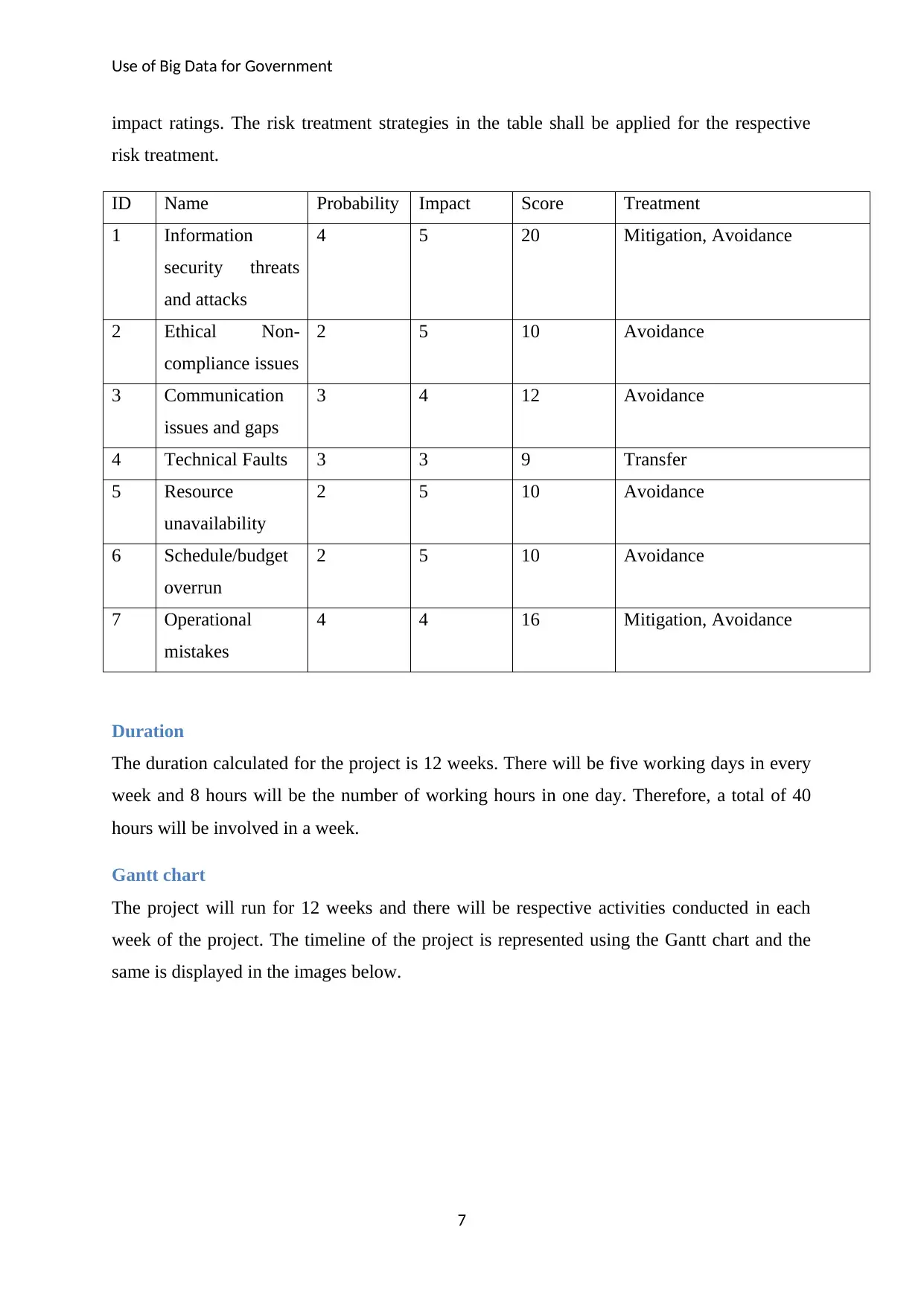
Use of Big Data for Government
impact ratings. The risk treatment strategies in the table shall be applied for the respective
risk treatment.
ID Name Probability Impact Score Treatment
1 Information
security threats
and attacks
4 5 20 Mitigation, Avoidance
2 Ethical Non-
compliance issues
2 5 10 Avoidance
3 Communication
issues and gaps
3 4 12 Avoidance
4 Technical Faults 3 3 9 Transfer
5 Resource
unavailability
2 5 10 Avoidance
6 Schedule/budget
overrun
2 5 10 Avoidance
7 Operational
mistakes
4 4 16 Mitigation, Avoidance
Duration
The duration calculated for the project is 12 weeks. There will be five working days in every
week and 8 hours will be the number of working hours in one day. Therefore, a total of 40
hours will be involved in a week.
Gantt chart
The project will run for 12 weeks and there will be respective activities conducted in each
week of the project. The timeline of the project is represented using the Gantt chart and the
same is displayed in the images below.
7
impact ratings. The risk treatment strategies in the table shall be applied for the respective
risk treatment.
ID Name Probability Impact Score Treatment
1 Information
security threats
and attacks
4 5 20 Mitigation, Avoidance
2 Ethical Non-
compliance issues
2 5 10 Avoidance
3 Communication
issues and gaps
3 4 12 Avoidance
4 Technical Faults 3 3 9 Transfer
5 Resource
unavailability
2 5 10 Avoidance
6 Schedule/budget
overrun
2 5 10 Avoidance
7 Operational
mistakes
4 4 16 Mitigation, Avoidance
Duration
The duration calculated for the project is 12 weeks. There will be five working days in every
week and 8 hours will be the number of working hours in one day. Therefore, a total of 40
hours will be involved in a week.
Gantt chart
The project will run for 12 weeks and there will be respective activities conducted in each
week of the project. The timeline of the project is represented using the Gantt chart and the
same is displayed in the images below.
7
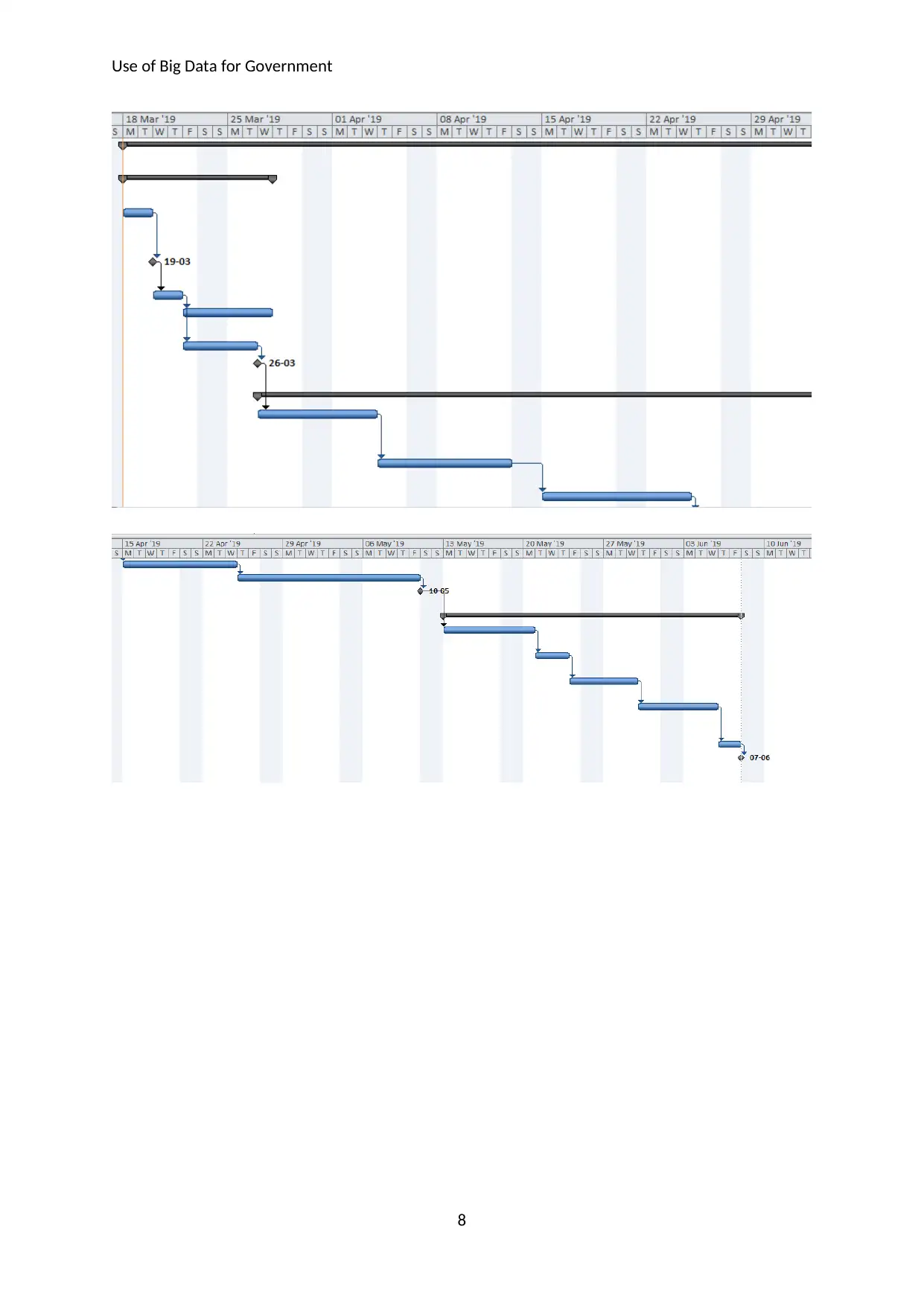
Use of Big Data for Government
8
8
⊘ This is a preview!⊘
Do you want full access?
Subscribe today to unlock all pages.

Trusted by 1+ million students worldwide
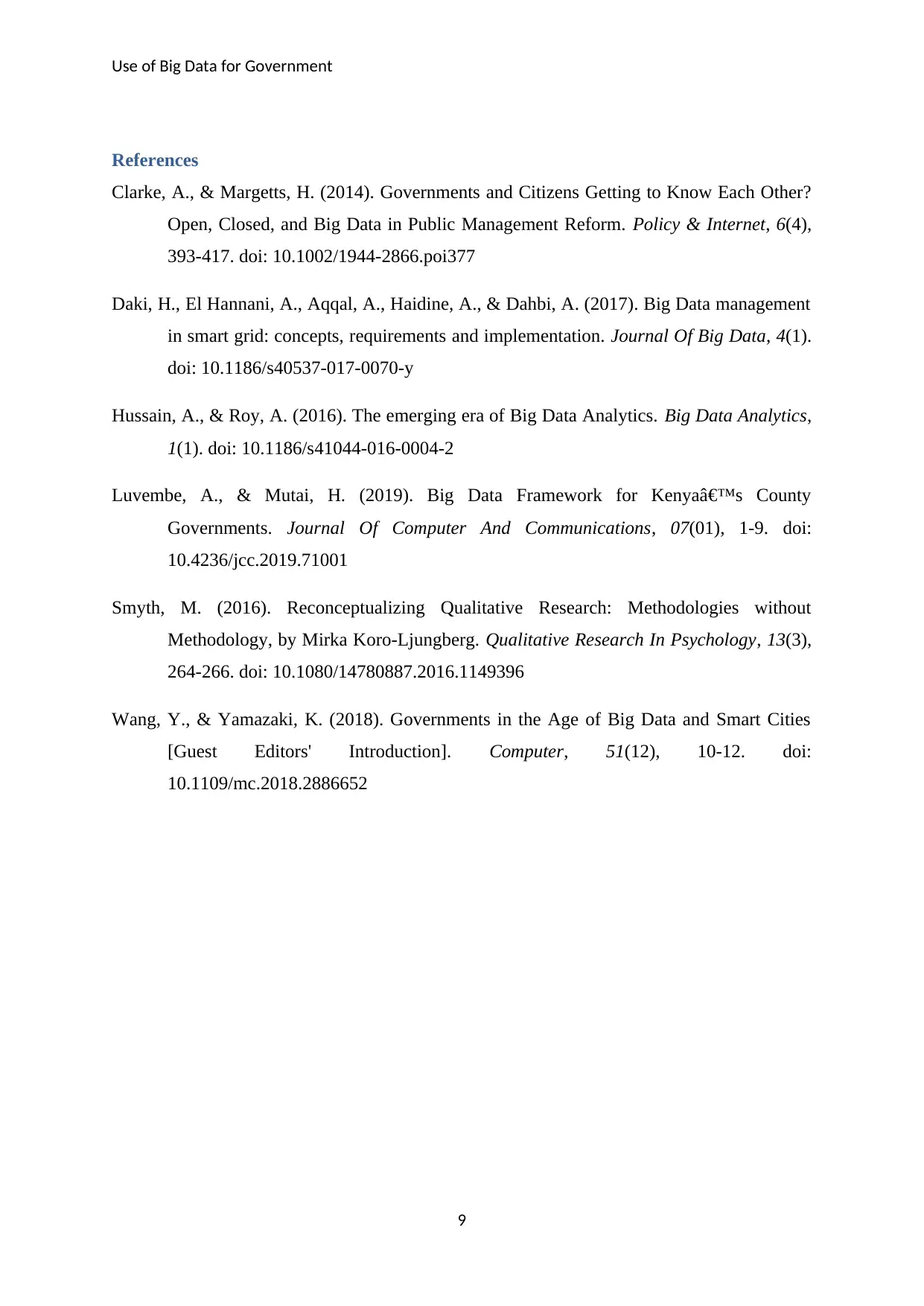
Use of Big Data for Government
References
Clarke, A., & Margetts, H. (2014). Governments and Citizens Getting to Know Each Other?
Open, Closed, and Big Data in Public Management Reform. Policy & Internet, 6(4),
393-417. doi: 10.1002/1944-2866.poi377
Daki, H., El Hannani, A., Aqqal, A., Haidine, A., & Dahbi, A. (2017). Big Data management
in smart grid: concepts, requirements and implementation. Journal Of Big Data, 4(1).
doi: 10.1186/s40537-017-0070-y
Hussain, A., & Roy, A. (2016). The emerging era of Big Data Analytics. Big Data Analytics,
1(1). doi: 10.1186/s41044-016-0004-2
Luvembe, A., & Mutai, H. (2019). Big Data Framework for Kenya’s County
Governments. Journal Of Computer And Communications, 07(01), 1-9. doi:
10.4236/jcc.2019.71001
Smyth, M. (2016). Reconceptualizing Qualitative Research: Methodologies without
Methodology, by Mirka Koro-Ljungberg. Qualitative Research In Psychology, 13(3),
264-266. doi: 10.1080/14780887.2016.1149396
Wang, Y., & Yamazaki, K. (2018). Governments in the Age of Big Data and Smart Cities
[Guest Editors' Introduction]. Computer, 51(12), 10-12. doi:
10.1109/mc.2018.2886652
9
References
Clarke, A., & Margetts, H. (2014). Governments and Citizens Getting to Know Each Other?
Open, Closed, and Big Data in Public Management Reform. Policy & Internet, 6(4),
393-417. doi: 10.1002/1944-2866.poi377
Daki, H., El Hannani, A., Aqqal, A., Haidine, A., & Dahbi, A. (2017). Big Data management
in smart grid: concepts, requirements and implementation. Journal Of Big Data, 4(1).
doi: 10.1186/s40537-017-0070-y
Hussain, A., & Roy, A. (2016). The emerging era of Big Data Analytics. Big Data Analytics,
1(1). doi: 10.1186/s41044-016-0004-2
Luvembe, A., & Mutai, H. (2019). Big Data Framework for Kenya’s County
Governments. Journal Of Computer And Communications, 07(01), 1-9. doi:
10.4236/jcc.2019.71001
Smyth, M. (2016). Reconceptualizing Qualitative Research: Methodologies without
Methodology, by Mirka Koro-Ljungberg. Qualitative Research In Psychology, 13(3),
264-266. doi: 10.1080/14780887.2016.1149396
Wang, Y., & Yamazaki, K. (2018). Governments in the Age of Big Data and Smart Cities
[Guest Editors' Introduction]. Computer, 51(12), 10-12. doi:
10.1109/mc.2018.2886652
9
1 out of 10
Related Documents
Your All-in-One AI-Powered Toolkit for Academic Success.
+13062052269
info@desklib.com
Available 24*7 on WhatsApp / Email
![[object Object]](/_next/static/media/star-bottom.7253800d.svg)
Unlock your academic potential
Copyright © 2020–2025 A2Z Services. All Rights Reserved. Developed and managed by ZUCOL.





